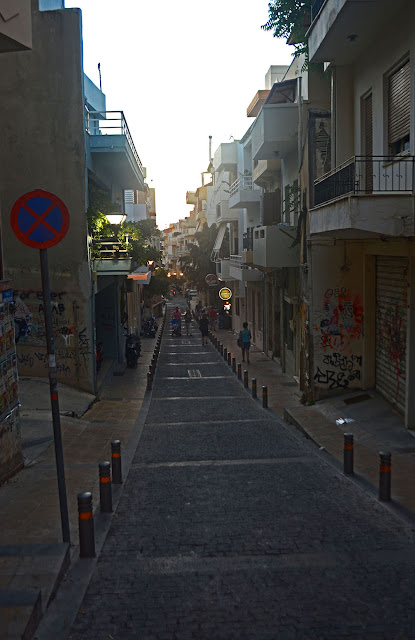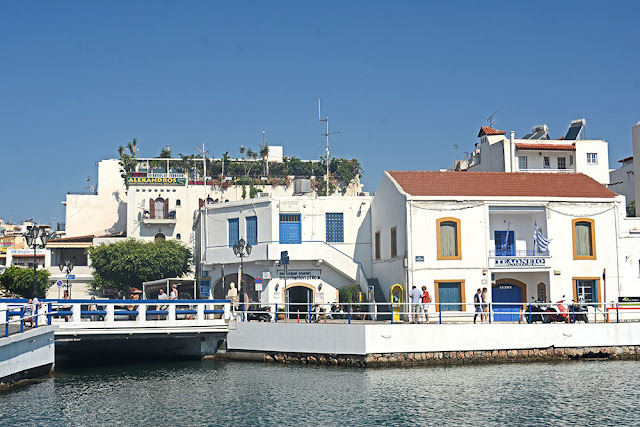Before getting into the thick of this post, which will cover the essential
topics of what to see and what to consume on Crete, I might as well share my
hopeless attempts of making sense of the Greek language, yet another mirror to
the always changing Hellenic soul.
The attempt to google a definitive alphabet was the initial failure- well,
there’s this version, and that, and some diacritics were used up to a point,
but not any longer, then there’s different letters for the same sound, and the
difference is historical and makes no logical sense whatsoever if you’re not a
scholar of Ancient Greek. The very fact that they often use a year to pinpoint
the start of Modern Greek, that of the fall of Constantinople, of course, which
has nothing to do with linguistic aspects, is a bad sign already. The need to
add the year to a present day Greek’s language resume has always amused me- it
would probably be very difficult to provide customer service in Ancient Greek
these days, though of course one could ponder the exquisite joys of yelling ’This
is Sparta!’ over the phone to a befuddled Athenian who lost the password to her
papyrus.
So try as I might, I still could not get beyond the hello and thank you,
but I can spend a jolly good time ogling the Greek side of a menu and still not
know what the hell I am about to order.
What to Eat and Drink. The drinks part is the easier one: don’t
drink bloody continental lagers and ridiculously overpriced cocktails. Fix,
Alfa and Mythos are great summer beers, plus there’s the usual array of ouzos
and local brandy, going by the name of either raki or tsikoudia. In a slightly
confusing touch, raki is indeed the soul brother of Romanian rachiu, so
essentially grape brandy, and not of the geographically closer lying Turkish rakı, which is, logically, ouzo. (If you were not confused enough, raki and
tsikoudia are known as tsipouro in other parts of Greece.)
Local wines can be a bit pricey in restaurants, but you can always opt for
a decent house wine in a carafe or for the nec plus ultra of Greek drinks-
retsina, resinated wine, most definitely
an acquired taste, but totally addictive once acquired. Legend actually has it
that in undiluted form it killed some Viking kings, which is no mean feat, but
the only trauma I can vouch for is desperately asking around wine stores for a
bottle of the miraculous golden fluid only to be told they have no idea what on
earth I’m blabbering about.
The food part is, you’ve guessed correctly, slightly approximative and a
tad confusing- but delicious. One has a general idea of what Greek food is,
along the lines of tzatziki, Greek salad and moussaka, but the rest of what can
be found on the Greek isles comes from the most diverse of sources- quite often
old overlords of each particular island, in our case the Venetians (those
people did potter around quite a lot in the Mediterranean) and the Turks.
So you can quite often find pasta meals included in the Greek food category
without a second thought, and the bean dish which I have always known as
Turkish kuru fasülye is also a local staple. Otherwise Crete has all the
strengths of the region- wonderful olives, fish and cheeses, and generally all
kinds of fresh vegetables and spices. The desserts are of the more Turkish
honey sweet variety, like kataifi, but I also encountered small cheese pies
which bear a ghastly resemblance to the Hungarian csőröge.
The where to eat part should come as a surprise to no one: try to wander
away from the obvious tourist routes and go for tavernas that have at least a
couple of locals mingled with the crowd. Because every rule has an exception,
one of the best places in Heraklion is located in the very heart of the city,
in the Agio Titou square, and happens to be a Turkish fast food- Izmir Kebap. Yes yes, only a hopeless idiot would go for a Turkish kebab place abroad (and not in Turkey), but trust me on this one, it's worth the risk of sounding daft a million times.
What to See. I’ll have to start with a warning: I am most definitely the anti social type of traveler who avoids tourist attractions like the plague. The only such place I ventured to on Crete was the Minoan palace of Knossos, and I paid for it dearly, having to put up with the oafish behaviour of barbaric hordes of tourists. It would probably make the whole visit a lot more comfortable if everyone wishing to enter would be submitted to a quick test of Ancient Greek history and mythology, and only those who passed would be allowed to enter. The rest could eventually be signed up for a short chase by the Minotaur and then sent on their way to never return. This would of course be financially catastrophic for the island of Crete, so there we were, among people who don’t even look at the place, but snap non stop selfies to be immediately uploaded to Instagram: Idiot with Vase, early 21st century.
What to See. I’ll have to start with a warning: I am most definitely the anti social type of traveler who avoids tourist attractions like the plague. The only such place I ventured to on Crete was the Minoan palace of Knossos, and I paid for it dearly, having to put up with the oafish behaviour of barbaric hordes of tourists. It would probably make the whole visit a lot more comfortable if everyone wishing to enter would be submitted to a quick test of Ancient Greek history and mythology, and only those who passed would be allowed to enter. The rest could eventually be signed up for a short chase by the Minotaur and then sent on their way to never return. This would of course be financially catastrophic for the island of Crete, so there we were, among people who don’t even look at the place, but snap non stop selfies to be immediately uploaded to Instagram: Idiot with Vase, early 21st century.
Idiots put aside, the place is absolutely wonderful to anyone with a
genuine interest in Ancient history. It’s not a spectacular place by any means,
but I was excited giddy at the thought of Minoans building such a complex
structure at a time when my part of the world was inhabited by wild deer and
possibly one or two inebriated Thracians.
Heraklion is basically a humbug, but one can spend a pleasant enough
evening walking the whole length of the pier in the Venetian port, occasionally
spotting plane and boat action and listening to the distant roar of an open air
concert performed by what could very well be the Cretan cousin of Avicii. (That man will haunt me to my grave.)
The old cities of Chania and Rethymno are much more exciting though, with
lots of nooks and crannies to be explored- a belated thank you to La
Serenissima and the Ottoman Empire for making the Mediterranean an exciting
place for future generations by their constant meddling, bickering and
conquering this and that, thus producing a fabulous mixture of cultures. This was most probably lost on their contemporaries, who saw them as the never ending nuisance that they were, but time has this gift of painting over the ugly parts. Another exciting escape on the northern shore is Agios Nikolaos, which is
postcard pretty and claims the fame of featuring in the BBC series Lotus
Eaters, and generally being a darling of the European jet set in the 60s and
70s.
All these places on the north coast are connected by the famous E75
European route, which begins to the east of Agios Nikolaos, in the town of
Sitia, and goes all the way to Vardø in Norway involving two ferry crossings in
the process (Chania to Athens and Gdynia to Helsinki) and also passing through
the fair city of Budapest.
There's of course so much more to see and do, but one week is definitely not enough for an island the size of Crete (another useful tip here, I'm on a roll), especially if you want to give yourself time to enjoy the beaches as well. And yes, because we shun the mainstream, we did not make it to either Elafonisi (the Barbie pink beach) or Vai (the palm tree beach), but Crete is just too good not to go back- so probably, one day, we'll simply have to give in.
There's of course so much more to see and do, but one week is definitely not enough for an island the size of Crete (another useful tip here, I'm on a roll), especially if you want to give yourself time to enjoy the beaches as well. And yes, because we shun the mainstream, we did not make it to either Elafonisi (the Barbie pink beach) or Vai (the palm tree beach), but Crete is just too good not to go back- so probably, one day, we'll simply have to give in.



















No comments:
Post a Comment